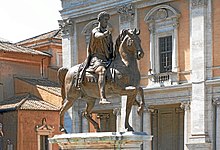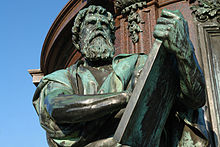Equestrian monument to Friedrich Franz II.
The equestrian monument of Friedrich Franz II. In Schwerin is the only historical equestrian monument in Mecklenburg and the main work of the sculptor Ludwig Brunow .
history
On April 15, 1883, the Grand Duke Friedrich Franz II of Mecklenburg died of pneumonia. The solemn burial in Schwerin Cathedral had barely passed when the court decided to erect a monumental memorial to the Grand Duke. The Mecklenburg-born sculptor Ludwig Brunow was asked for a cost estimate for an equestrian monument with an extensive base design. He put the cost at 250,000 marks.
In September of that year, the first call for donations started and appeared in 55 Mecklenburg newspapers. The Mecklenburg consulates abroad and at the imperial court were also trying to find compatriots willing to donate. This action quickly showed success, in January 1885, 218,000 marks were already available, the remaining amount was to be achieved by paying interest on the donated money.
The designs and models

In the fall of 1884, Brunow presented three detailed drafts, which were widely approved by the commissioning monument committee. Grand Duke Friedrich Franz III. expressed his approval and gave the artist small suggestions, including the arrangement of the base figures.
Models for the artist were the late antique equestrian statue of the Roman Emperor Marc Aurel in Rome and the baroque equestrian statue of the Great Elector in Berlin.
The initially planned pedestal figures symbolized as allegorical representations with reference to the Grand Duchy of Mecklenburg: “Armed forces”, “Nourishing agriculture”, “Care of science” and “Trade and shipping”. This iconography was later changed in favor of the four ruler's virtues "strength" (defense), "justice" (law), "wisdom" and "faith". Likewise, the artist later had to bow to the Grand Duke's wishes for the motifs of the base reliefs. One relief initially envisaged: “a genius of architecture on a Corinthian capital lying on the ground, charming putti occupied with building plans and tools from the builders on the left and right, in the background the outlines of the main buildings from the reign of Friedrich Franz II. = Arts of the Peace. "The other relief should show:" Victoria with a laurel wreath and palm branch in her hands, putti on both sides with drums, trumpets and trophies = the art of war. "
The artist submitted a detailed cost estimate in September 1885. For the total sum of 272,000 marks Brunow wanted the equestrian statue in bronze of 1 2/3 natural size (4.57 m with a total height of approx. 9 m), four allegorical base figures in bronze of 1 ½ natural size, two image reliefs in bronze and deliver the granite base, including all preparatory work.
In December 1887, he reported the completion of the auxiliary models in accordance with the contract. In April 1889, the first two casting models for the base figures "Law" and "Piety" were completed. In the meantime, Schäffer & Walcker , a well-known foundry in Berlin, was under contract with the artist. Cast, chased and patinated, the two figures were ready for acceptance in April 1890. With the approval of the monument committee at short notice, Brunow was able to present the two sculptures at the Great Berlin Art Exhibition of 1890. The order for the plinth went to the stonemason company Kessel & Röhl in Berlin. The total height of the plinth was designed to be 4.10 m, the sides should be rounded off oval with approx. 1.00 m high pedestals for the seated corner figures.
At the beginning of June 1890, the cast models for horse and rider were completed and expertly assessed by the sculptor Alexander Calandrelli . After that, the models stayed for a few months in Brunow's studio for free viewing, where u. a. Kaiser Wilhelm II expressed his keen interest.
In the summer of 1891, the sculptor Brunow was fully occupied with modeling the reliefs, the motifs of which had since been changed at the request of the Grand Duke:
- "Entry of Grand Duke Friedrich Franz II. 1871 into Schwerin"
- "Inauguration of the new university building in Rostock in 1871"
The figures in the reliefs show numerous contemporary personalities, some of whom are named on the edge of the reliefs. On the so-called “indentation relief”, Brunow also immortalized himself in the curious public.
In the meantime, the casting of the equestrian statue was completed in August 1891. By June 1892, the remaining corner figures "Wisdom" and "Wehrkraft" were finished to the full satisfaction of all those involved.
inauguration
The Grand Duke set the solemn unveiling of the monument on August 24, 1893. The extensive guest list was headed by Kaiser Wilhelm II and his family. In addition to the imperial and grand ducal families, the following were invited: Grand Duke Vladimir of Russia with his family, Duke Ernst I of Saxony-Altenburg , Prince Adolf of Schwarzburg-Rudolstadt , Prince Reuss j. L. Heinrich VII. (The brother of Auguste Reuss zu Köstritz , Friedrich Franz II. First wife) and Heinrich XVIII. as well as numerous other court nobility. Bourgeois guests and residents of the city could - as long as they were not guests of honor - purchase tickets.
For the military framing of the celebration: the 1st company of the Fusilier Regiment No. 90 from Rostock and an squadron of the Dragoon Regiment No. 17 and 18 from Ludwigslust. In addition, the 3rd Battalion of Grenadier Regiment No. 89 from Schwerin played. After a few hymns and hymns of praise to the blessed Friedrich Franz II, as well as a celebratory speech written by archivist Friedrich Schlie , the covers of the monument fell and the royal seat was enriched by a landmark. Sculptor Ludwig Brunow, for whom the equestrian monument was the high point of his artistic life, was awarded the “Knight's Cross of the House Order of the Wendish Crown ” and the dignity of “Grand Ducal Professor” for his work .
In September 1942, the fact that after a short research it was assigned to the grand ducal property and thus spared state confiscation proved to be fateful for the preservation of the monument. The Reich Ministry of War had previously asked the city to dismantle the four corner figures and melt them down for armament. The extent to which the monument was endangered after the war is shown by the efforts of the GDR Ministry of Public Education in the summer of 1951 to scrap the bronze "economically necessary", which could still be prevented by the skillful influence of the state monument keeper and the tedium of the bureaucracy. Thus, the equestrian memorial survived the war years and the iconoclasm afterwards undamaged as an excellent testimony to Mecklenburg (art) history.
The whereabouts of the cast models
Immediately after all the bronze parts had been cast, Brunow made suggestions to the monument commission in July 1893 about the whereabouts of the individual large models, it would be a shame to destroy them. He suggested the following possible locations:
- the equestrian statue in the Rostock town hall,
- "Justice" (law) in the Rostock Higher Regional Court,
- "Faith" (piety) in the consistory hall in Rostock,
- "Strength" (military strength) in the arsenal Schwerin,
- "Wisdom" in the University of Rostock,
- the "indentation relief" in a public building,
- the "University Relief" in the University of Rostock.
While there are still no clear results about the fate of the reliefs and base figures - with the exception of wisdom - there are those about that of the equestrian figure. This has been set up in the upper town hall in Rostock. In 1901, however, cracks appeared in the floor, which resulted in the removal of the statue weighing around 2500 kg. For financial reasons, the proposal to replace the plaster model with a smaller replica in bronze was not implemented.
The auxiliary model was verifiably placed in the military history collection of the arsenal in Schwerin, where it replaced a plaster bust that was consecrated on April 15, 1884 on the 1st anniversary of the Grand Duke's death. In the course of 1922 the collection was given to the State Museum. Some of them were exhibited in Schwerin Castle and were located here until 1945. Nothing more is known about the whereabouts of the memorial model.
Replicas
For Otto von Bismarck's 80th birthday , Das dank Mecklenburg had a replica of the entire monument modeled by Ludwig Brunow himself, almost one meter high, made and cast in bronze by Schäffer & Walcker in Berlin. After a public exhibition in Güstrow, Rostock and Schwerin, a year later in May 1896 a delegation of 17 gentlemen led by Friedrich Schlie brought the gift to the former Chancellor in his retirement home in Friedrichsruh. Later inventoried in the Bismarck Museum Schönhausen, this specimen came up for auction on January 19, 2016 at Sotheby's in London.
Unsigned replicas of the equestrian statue without a base in bronzed zinc cast are also known, one example was offered and sold on Ebay in 2007, another at an auction in Munich in 2015.
literature
- Friedrich Schlie : The monument of the Grand Duke Friedrich Franz II of Mecklenburg-Schwerin. In memory of August 24th , 1893, Schwerin 1893
- Wolfgang Vomm : Equestrian statues of the 19th and early 20th centuries in Germany , Bergisch Gladbach 1979, 2 vols.
- Bernd Kasten: The entry of the Mecklenburg troops into Schwerin on June 14, 1871 in picture and reality , In: Mecklenburgische Jahrbücher 125th year 2010, p. 251 ff., ISSN 0930-8229
Web links
Individual evidence
- ↑ Mecklenburg State Main Archives, Grand Ducal Cabinet III, Sig. 5290/04
- ↑ National-Zeitung No. 380 v. July 8, 1887
- ↑ Westermann's illustrated German monthly books , Volume 73, Westermann 1893, p. 778.
- ↑ Schweriner People's Newspaper. Mecklenburg Magazine No. 19/2000
- ↑ Keubke: Das Arsenal - A landmark in Schwerin, Schwerin 1998, p. 38
- ^ Neue Hamburger Zeitung of May 17, 1896
- ↑ http://www.sothebys.com/en/auctions/ecatalogue/lot.447.html/2016/of-royal-and-noble-descent-l16306 online catalog lot 447 with auction details
Coordinates: 53 ° 37 ′ 20.6 ″ N , 11 ° 25 ′ 0.8 ″ E




